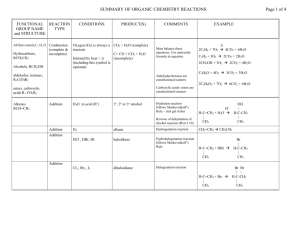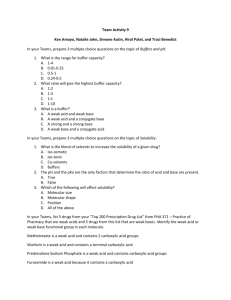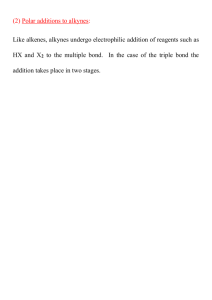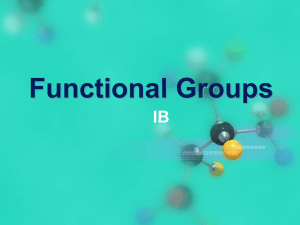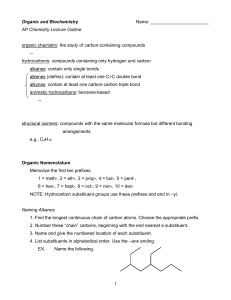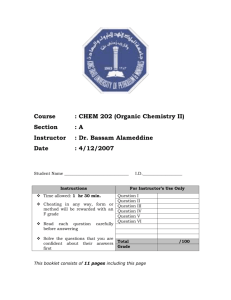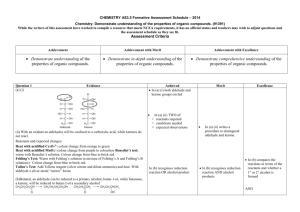PRODUCTS OF ORGANIC CHEMISTRY REACTIONS
advertisement
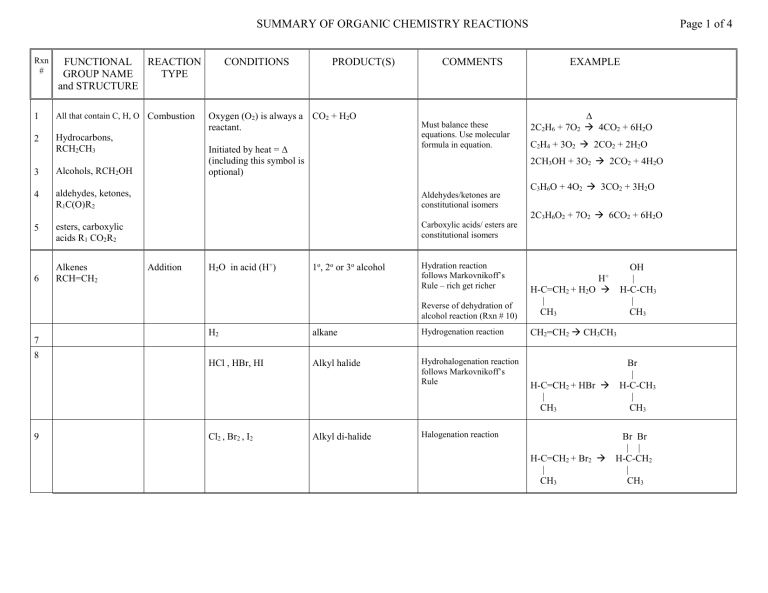
SUMMARY OF ORGANIC CHEMISTRY REACTIONS Rxn # FUNCTIONAL REACTION GROUP NAME TYPE and STRUCTURE 1 All that contain C, H, O Combustion 2 Hydrocarbons, RCH2CH3 CONDITIONS PRODUCT(S) Oxygen (O2) is always a CO2 + H2O reactant. Initiated by heat = ∆ (including this symbol is optional) COMMENTS Must balance these equations. Use molecular formula in equation. Alcohols, RCH2OH 4 aldehydes, ketones, R1C(O)R2 Aldehydes/ketones are constitutional isomers 5 esters, carboxylic acids R1 CO2R2 Carboxylic acids/ esters are constitutional isomers 6 7 8 9 Addition H2O in acid (H+) 1o, 2o or 3o alcohol Hydration reaction follows Markovnikoff’s Rule – rich get richer ∆ 2C2H6 + 7O2 4CO2 + 6H2O C2H4 + 3O2 2CO2 + 2H2O 2C3H6O2 + 7O2 6CO2 + 6H2O OH | H-C-CH3 | CH3 Reverse of dehydration of alcohol reaction (Rxn # 10) CH2=CH2 CH3CH3 alkane Hydrogenation reaction HCl , HBr, HI Alkyl halide Hydrohalogenation reaction follows Markovnikoff’s Rule Alkyl di-halide C3H6O + 4O2 3CO2 + 3H2O H+ H-C=CH2 + H2O | CH3 H2 Cl2 , Br2 , I2 EXAMPLE 2CH3OH + 3O2 2CO2 + 4H2O 3 Alkenes RCH=CH2 Page 1 of 4 H-C=CH2 + HBr | CH3 Halogenation reaction H-C=CH2 + Br2 | CH3 Br | H-C-CH3 | CH3 Br Br | | H-C-CH2 | CH3 SUMMARY OF ORGANIC CHEMISTRY REACTIONS (continued) Rxn # FUNCTIONAL GROUP NAME and STRUCTURE REACTION TYPE 10 Alcohols – hydroxy 1o RCH2OH Elimination , dehydration – CONDITIONS PRODUCT(S) Acid catalyzed (H+) with Most substituted alkene heat. Page 2 of 4 COMMENTS Saytseff’s rule – poor get poorer loss of H2O 2o RCHOHCH3 EXAMPLE OH | H+ CH3-CH2-C-CH3 CH3-CH=C-CH3 + H2O | | CH3 CH3 3o RC(CH3)2OH H OH There must be a H on an adjacent C otherwise NoReaction 11 Oxidation H+ NR [O] conditions. Some oxidizing agents = 1o give aldehydes first, CrO3 , H2CrO4 , K2Cr2O7 then carboxylic acids OH O O | [O] || [O] || CH3-CH2 CH3-CH CH3-COH Reverse of reduction of aldehyde or ketone reaction (Rx # 15) 2o give ketones 12 OH | [O] CH3-C-CH3 NR | CH3 3o No Reaction 13 14 Aldehyde R-C=O | H 15 Ketone R1-C=O | R2 Oxidation [O] conditions. Some oxidizing agents = Aldehydes give carboxylic CrO3 , H2CrO4 , K2Cr2O7 acids Tollens (Ag+) NAD+ (biological) Ketones No reaction OH O | [O] || CH3-CH2-CH-CH3 CH3-CH2-C-CH3 Only aldehydes are oxidized O O || [O] || CH3-CH CH3-COH O || [O] CH3-CH2-C-CH3 NR SUMMARY OF ORGANIC CHEMISTRY REACTIONS (continued) Rxn # 16 FUNCTIONAL GROUP NAME and STRUCTURE Carboxylic acid R-C=O | OH REACTION TYPE CONDITIONS Neutralization Reaction with any base. Usually OH- or any amine (1o, 2o, 3o) PRODUCT(S) Carboxylic acid + inorganic base gives carboxylate ion COMMENTS Same as amine neutralization reaction above (Rxn #18) Carboxylic acid + amine gives carboxylate ion + ammonium ion 17 Combination - Reaction of any ester esterification carboxylic acid with any alcohol , catalyzed by acid and heated Combination – Acid + amine + heat. amide product 18 Reaction with 1o gives a 2o amide. Reaction with 2o amine gives 3o amide Reaction with 3o amine does not give amide, only neutralization product. 19 Ester R1-C=O | OR2 Hydrolysis Ester + acid or base + heat Reverse of esterification reaction Acid catalysiscarboxylic acid + alcohol Base catalysis carboxylate ion + alcohol Page 3 of 4 EXAMPLE O O || || CH3-COH + NaOH CH3-CO- + Na+ + H2O O O || || CH3-COH + (CH3)3N CH3-CO- + (CH3)3NH+ Catalyzed by acid. Anhydride + alcohol gives ester product without acid catalysis Same reaction as amide formation reaction already described in amines (Rxn # 21-24, below) Reverse of ester forming reaction (Rxn # 17, above) O O || H+ || CH3OH + CH3-COH CH3-COCH3 + H2O O O O O || || || || H-C-O-C-H + CH3-OH H-COH + CH3-O-C-H ester O O || ∆ || CH3NH2 + CH3-COH CH3-CNHCH3 + H2O O O || ∆ || (CH3)3N + CH3-COH CH3-CO- + (CH3)3NH+ not an amide+ O O || H+ || CH3-COCH3 + H2O CH3OH + CH3-COH O O || OH|| CH3-COCH3 CH3OH + CH3-CO- SUMMARY OF ORGANIC CHEMISTRY REACTIONS (continued) Rxn # 20 FUNCTIONAL GROUP NAME and STRUCTURE Amines RNH2 1o amine R2NH 2o amine R3N 3o amine REACTION TYPE CONDITIONS Neutralization. Reaction with any acid: inorganic or organic Combination – Reaction with carboxylic amide acid Requires heat. formation Otherwise only neutralization occurs (Like Rxn # 18 above) 21 22 PRODUCT(S) Ammonium ion + anion (carboxylate if acid is carboxylic acid) Rxn with organic acid O O || || CH3NH2 + CH3-COH CH3NH3+ + CH3-CO- Cl- O O || ∆ || CH3NH2 + CH3-COH CH3-CNHCH3 + H2O 24 Acid or base catalzyed CH3NH2 + HCl CH3NH3+ + Reaction with 1o amine gives a 2o amide. Reaction with 3o amine does not give amide, only neutralization products. Hydrolysis Rxn with inorganic acid O O || ∆ || NH3 + CH3-COH CH3-CNH2 + H2O Reaction with 2o amine gives 3o amide (rxn not shown) Amides R-C=O | NH2 EXAMPLE Ammonia + carboxylic acid gives primary amide 23 25 COMMENTS Page 4 of 4 Acid catalysis carboxylic acid + ammonium ion Base catalysis carboxylate ion + amine O O || ∆ || (CH3)3N + CH3-COH CH3-CO- + (CH3)3NH+ not an amide+ Reverse of amide forming reaction (Rxn # 18 and 2124 above) O || CH3-CNHCH3 H+ O || CH3-COH + CH3NH4+ O || CH3-CNHCH3 O OH|| CH3-CO- + CH3NH2
